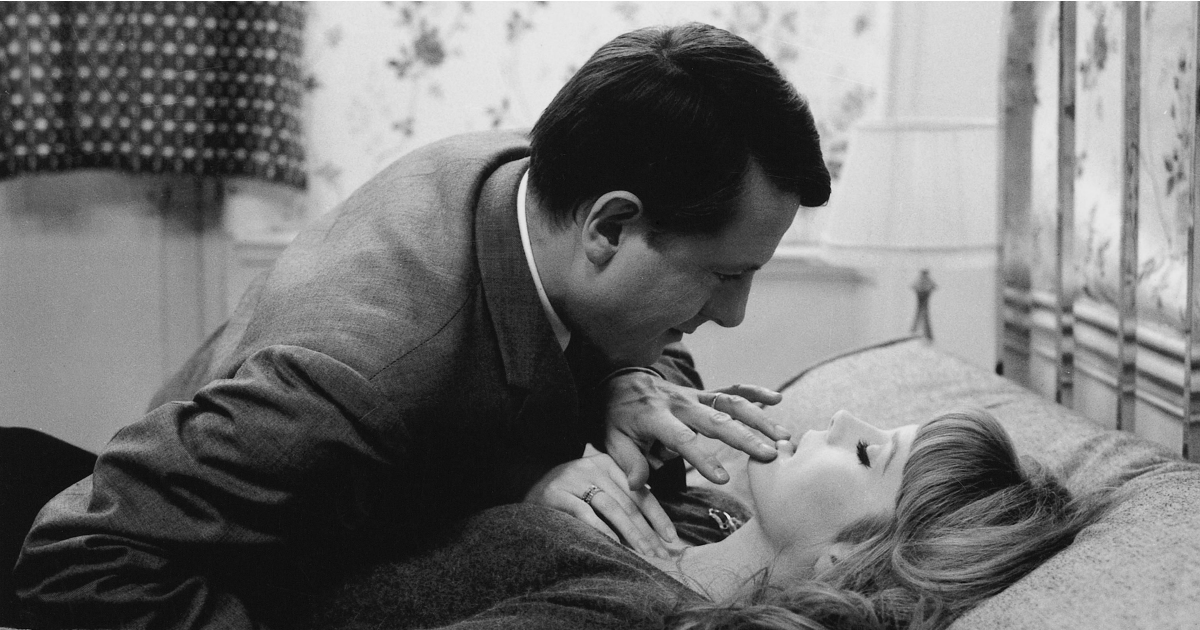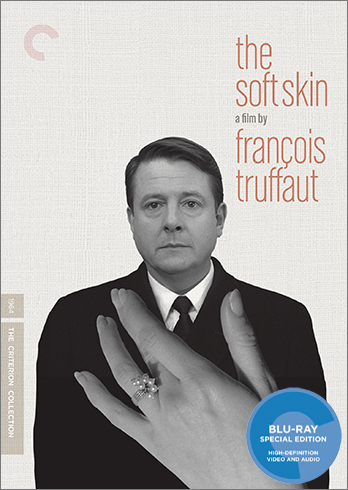
Back in 1964, when Francois Truffaut was pondering his options for a follow-up film to the triumphant Jules and Jim, he recalled later on in an interview that his imagination was captured by a random observation on the street. A man and woman, each married but not to each other, were engaged in a passionate kiss in the back seat of a taxi, a liplock of such ravenous intensity that their teeth made clacking noises. The embrace marked the end of some stolen time spent together, just before they would part ways with each other and return with practiced nonchalance to their normal domestic routines, joining their respective spouses and children in order to maintain a tranquil status quo.
Though nothing exactly like that encounter is recreated in The Soft Skin, the narrative and cinematic possibilities stirred up by all the ethical and emotional juggling that goes into carrying on an extramarital affair were evident to Truffaut and his screenwriting partner Jean-Louis Richard. They explored this fertile ground with the studied eyes of seasoned (though still relatively young) experts in that turf. From the initial moment of inspiration, they spun out a story that, as Richard went on to say a commentary track recorded in 2000 (long after Truffaut had passed away much too young), served as an intentionally mundane, somewhat depressing counterpoint to the “hymn to life” struck by Jules and Jim. So it’s not exactly all that surprising to learn that The Soft Skin was widely regarded as an artistic failure upon release, and was indisputably a box office flop. That probably goes a long way toward explaining why it’s taken the film this long to get the Criterion Collection release that, in the eyes of this viewer, it so clearly deserves. Maybe the world just had to get a bit more disillusioned, or Truffaut’s early enthusiasts had to endure more of life’s hard knocks, for audiences to warm up to a film that doesn’t go to obvious lengths to endear itself.
The story is told from the perspective of Pierre Lachenay, a renowned academic lecturer celebrated for his expertise on the French author Balzac. Having worked his way up to the level of a minor celebrity in the European literary scene, he now enjoys the trappings of success: a comfortable home with all the stylish bourgeois trimmings (scenes filmed in the very apartment that Truffaut and his then-wife inhabited at that time), a gorgeous spouse and well-mannered daughter, the respect of his professional peers and society VIPs who welcome him to lend prestige to various civic events. He gets to travel the continent, is generously compensated and basically enjoys as much comfort in life as any middle-aged man could reasonably ask for. And yet, despite all this ease of existence, and in apparent rejection of an affluent prosperity that so many in this world can only fantasize about enjoying, Lachenay seems to be restless, maybe even just plain bored.
I say “seems” because despite the fact that almost the entire film is focused either on him or on what he sees happening around him, we’re rarely privileged to learn much of what’s going on in the protagonist’s interior as he takes a bold and fateful step out of the genteel path he’d been traveling on for some years, getting himself involved in the aforementioned adulterous affair. On a flight to Portugal, he perceives the subtle hints of a pretty young stewardess’s availability and vulnerability, and when he discovers that they are staying at the same hotel, he quite uncharacteristically calls up to her room and arranges to meet for drinks the next day – even though it involves incorporating some significant adjustments to his itinerary in order to make it happen.
Perhaps it’s beginner’s luck for Lachenay, or maybe this whole picking-up-women-half-his-age thing was a lot easier to begin with than he ever imagined it could be, but Pierre’s first foray into cheating on his wife turns out to be quite a coup. At least in its early stages, both he and Nicole find much happiness in each other’s company. Their afternoons together provide the kind of pleasurable experience that easily and persistently calls out for further reinforcement. But that volatile entanglement, combined with Lachenay’s inexperience with this level of intrigue and his bumbling attempts to construct a fool-proof second life, quickly unravels in a series of scenes of painfully awkward heartbreak and confusion spread all around. The clumsy lies, the stony silences, the crafty manipulations of tears, anger, avoidance and desperate pleas for forgiveness and patience employed by Lachenay and his women are all rendered with a clarity and accuracy that will induce winces in anyone who’s ever paid attention to the games people play when infidelity must be concealed. The Soft Skin brilliantly shows the effects of moral compromise, conflicting desires and incompatible priorities on everyone involved – the wife, the mistress and, most bluntly, the self-serving husband whose sense of entitlement steered them all into this totally avoidable but all too common mess.
I’ve already spoken about how this film was written and directed as a reaction to the success and admiration generated by Jules and Jim, but the contrasting fates of those two films that brought to a conclusion the initial phase of Truffaut’s filmmaking career warrants further exploration. He deliberately chose a subject less charismatic and celebratory than either Jules or Jim (though Francoise Dorleac as Nicole is in my esteem just as compelling a presence on the screen as Jeanne Moreau’s Catherine in that earlier film): a bland, aging intellectual who’s coasting on his laurels, clearly overreaching with his amorous pursuit and unforgivably dissatisfied with the terms of his cozy lifestyle. Viewers of Truffaut’s previous efforts who presumably entered the theater expecting to be charmed by further adventures of sexy, exciting young performers as they were in The 400 Blows and Shoot the Piano Player can’t be faulted too much for feeling disappointed if that’s what they were looking for the director to provide, but it’s to his credit that Truffaut took a bolder and more adventurous approach than simply trying to curry the favor of a youthful baby boomer crowd. Indeed, The Soft Skin must have served as an unwelcome buzzkill to the burgeoning “free love” movement that was starting to swell its ranks in the mid-1960s.
In cinematic terms, Truffaut demonstrates a fair degree of indebtedness to his revered master, Alfred Hitchcock, with a strong reliance on short cuts, bold edits and discomforting moments of suspense to put us right in the middle of Lachenay’s point of view. That’s not exactly a “fun” place to be for most of the film, even when we’re vicariously enjoying the most carefree of moments that he shares with Nicole, since it’s obvious to anyone who’s paying attention that these are ephemeral diversions at best and won’t really lead to anything satisfying in the longer term. But the effect is still quite riveting, and it’s one of the chief aspects of this film that allows it to transcend the limitations of being merely a moralistic warning to would-be adulterers. Truffaut is demonstrating his own brilliance as an auteur via the fruits of his careful study of the man he considered to be the greatest director of them all.
That pivotal influence of Hitchcock, and in particular the way that Truffaut’s devoted appraisal of his work came into such sharp focus right around the time that he was shooting The Soft Skin, provides much of the context of this film that we get in the supplements on the new Criterion disc. It was in 1962, just after Hitchcock had finished filming The Birds, that Truffaut’s initial correspondence with Hitch led to the first of a series of interviews that would go on to supply the text for the seminal volume of film criticism titled simply Hitchcock. A new short essay by Kent Jones kicks off the conversation, an hour-long documentary by Robert Fischer explores the relationship of the two men over the decades, and we even get to hear from Truffaut himself speaking on the topic in a 1965 archival clip in which he discusses the making of this film while he was in the editing phase of writing his book, a project that precluded any work behind the camera until 1966, when he took on the job of filming Fahrenheit 451 (which I would love for Criterion – or anybody else – to release someday on a Blu-ray that doesn’t resemble this very sketchy looking object.)
On top of all that illuminating information, we’re also treated to a commentary track, recorded back in 2000 by Jean-Louis Richard (the film’s co-screenwriter) and Truffaut scholar Serge Toubiana. The two men come across as old friends who both enjoy reliving the memories of making the film and witnessing its initial, disappointing reception, which as it turns out didn’t really phase Truffaut at all. Indeed, he might have even been expecting the movie to bomb, given how it departed from his earlier work. One caveat about the commentary track – while it’s very helpful and a welcome addition to the package, it’s in French, so we have to occasionally work through two sets of subtitles, one from the translated dialogue of the movie itself, and the other, an English rendition of the two men’s conversation. At times, the commentary text completely overrides what’s being said on screen. It requires a bit more effort than usual, but I would be delighted if Criterion offers more of these non-English audio supplements in future releases, since it seems increasingly rare these days that they’re commissioning new commentaries in any language to accompany their films.
Finally, there’s the plain, grayscale cover art, featuring a befuddled looking Jean Desailly (as Pierre) with the enormously outsized hand of Nicole on the verge of clutching his throat (or is she merely smoothing his lapel and straightening his tie?) I’ll be the first to concede that it’s probably not the most aesthetically gratifying concept they could have gone with. The original poster of the film, in which we see Pierre tenderly leaning over his lovely paramour, would have been a serviceable image for Criterion to adapt. It might have even enhanced the disc’s commercial appeal – as I’m sure was the intent of the studio’s initial design. But now having seen and reflected on the film, I think the image they went with suits it perfectly – capturing the powerful allure, the inviting delicacy and the palpable danger, all at once exerted by the seeming innocence and passivity of The Soft Skin.






![Bergman Island (The Criterion Collection) [Blu-ray]](https://criterioncast.com/wp-content/uploads/2022/11/bergman-island-the-criterion-collection-blu-ray-400x496.jpg)
![This Is Not a Burial, It’s a Resurrection (The Criterion Collection) [Blu-ray]](https://criterioncast.com/wp-content/uploads/2022/11/this-is-not-a-burial-its-a-resurrection-the-criterion-collection-blu-ray-400x496.jpg)
![Lars von Trier's Europe Trilogy (The Criterion Collection) [The Element of Crime/Epidemic/Europa] [Blu-ray]](https://criterioncast.com/wp-content/uploads/2022/11/lars-von-triers-europe-trilogy-the-criterion-collection-the-element-of-400x496.jpg)
![Imitation of Life (The Criterion Collection) [Blu-ray]](https://criterioncast.com/wp-content/uploads/2022/11/imitation-of-life-the-criterion-collection-blu-ray-400x496.jpg)
![The Adventures of Baron Munchausen (The Criterion Collection) [4K UHD]](https://criterioncast.com/wp-content/uploads/2022/11/the-adventures-of-baron-munchausen-the-criterion-collection-4k-uhd-400x496.jpg)
![Cooley High [Criterion Collection] [Blu-ray] [1975]](https://criterioncast.com/wp-content/uploads/2022/11/cooley-high-criterion-collection-blu-ray-1975-400x496.jpg)